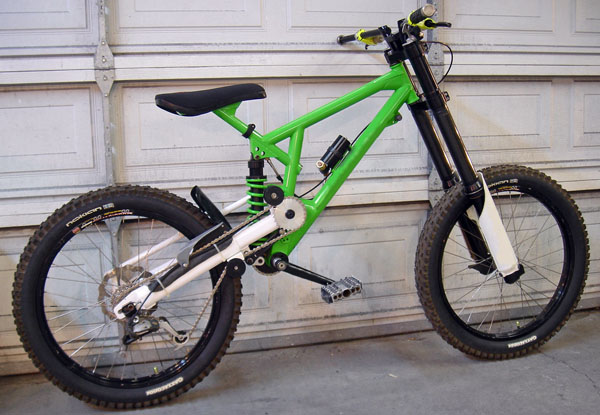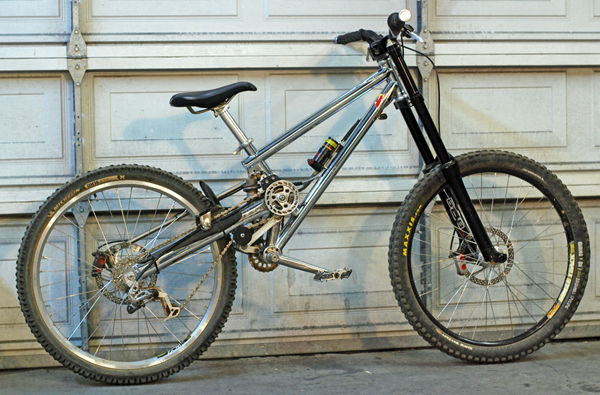Got some spare time (read I'm bored) so here's a history lesson, ripped off SuperCo & mtbr.
Chris Boudreaux was a Grundig World Cup champion Trials rider. He got his nickname, "Doc" from formal training and experience as a medical doctor. He was a passionate fighter from BMX to downhill racing.
"I started my riding career in BMX racing in 1979, and bicycles have been my main passion ever since," says Boudreaux, who grew up outside of Baltimore, Maryland. "Over the years of riding and racing, I began to dream of product ideas of my own."
As Boudreaux matured, so did his interests in bicycle competition, moving from BMX to observed trials in the late 1980s. The precision that was demanded of him in trials riding was the perfect complement to the time Boudreaux spent attending Mt. Sinai Medical School in New York City. He earned his MD in 1993 as a specialist in infectious diseases and orthopedics then served as a Centers for Disease Control and Prevention liaison to the NYC Department of Health until 1996, when he reached the proverbial fork in the road - should the rest of his life follow career, or his passion?
"I had the kind of opportunity that doesn't happen very often," says Boudreaux, who spent what little free time he had riding and designing frames and components "The dreams that I had back then came together with the establishment of a new bicycle company where I would follow my vision from concept, to design and manufacture, to a finished product that not only I could ride, but others could enjoy as well." Boudreaux became co-owner of a bike company that went against most, if not all, trends. His imaginative designs and skilled manufacturing talents attracted a hard-core cadre of customers who appreciated the small company for its all-steel downhill and dirt jumping frames.
Boudreaux's first solo efforts on frame building - from conception to completion to testing - came in 1997 with a full suspension BMX bike
and a 70lbs behemoth downhill bike called the Supertrucker with a jackshaft drive and internal geared hub.
His second downhill frame, the TMX was originally created in 1999
Also in late 2000 Doc's preliminary suspension exploration was taken one-step beyond with the creation of The Master Plan.
It was a purely experimental bike designed to test suspension, braking and body positioning. The experience gained was quickly utilized in the 2001 Big Link, his first bike with a linkage driven shock configuration.
As Doc's fabricating and riding requirements continued to evolve so did the side projects he challenged himself with. He returned to NYC from a pivotal May 2001 trip to Utah with the goal of making the smallest lightest bike possible utilizing the same proven linkage and jack shaft design of the Big Link, which was a burley 65lbs. Several months later he emerged from the shop with a six-inch travel all-mountain bike capable of handling the terrain at his favorite Northeast resort while also serving exceptionally well on the September follow-up trip to Utah that same year. The 36lbs FQ Mini Link was another of his self-funded side projects forced into limited production at the company by popular demand.
In 2002 Doc had been working on a downhill frame design that would have been years away from going into production at the old company had it not been for the early support of Avalanche Downhill Racing who was looking for a new team bike at the time. Later that year, Avalanche team rider John McCann won the Semi Pro class at the Mount Snow National aboard one of these Race Links.
It wasn't long before Doc compiled a hearty list of changes required to make the Race Link truly race-worthy for all conditions but without a concerted effort under one roof these undertakings were insurmountable. The bike ended up being the last production frame Doc would design for his old company (BMW).
Got some spare time (read I'm bored) so here's a history lesson, ripped off SuperCo & mtbr.
Chris Boudreaux was a Grundig World Cup champion Trials rider. He got his nickname, "Doc" from formal training and experience as a medical doctor. He was a passionate fighter from BMX to downhill racing.
"I started my riding career in BMX racing in 1979, and bicycles have been my main passion ever since," says Boudreaux, who grew up outside of Baltimore, Maryland. "Over the years of riding and racing, I began to dream of product ideas of my own."
As Boudreaux matured, so did his interests in bicycle competition, moving from BMX to observed trials in the late 1980s. The precision that was demanded of him in trials riding was the perfect complement to the time Boudreaux spent attending Mt. Sinai Medical School in New York City. He earned his MD in 1993 as a specialist in infectious diseases and orthopedics then served as a Centers for Disease Control and Prevention liaison to the NYC Department of Health until 1996, when he reached the proverbial fork in the road - should the rest of his life follow career, or his passion?
"I had the kind of opportunity that doesn't happen very often," says Boudreaux, who spent what little free time he had riding and designing frames and components "The dreams that I had back then came together with the establishment of a new bicycle company where I would follow my vision from concept, to design and manufacture, to a finished product that not only I could ride, but others could enjoy as well." Boudreaux became co-owner of a bike company that went against most, if not all, trends. His imaginative designs and skilled manufacturing talents attracted a hard-core cadre of customers who appreciated the small company for its all-steel downhill and dirt jumping frames.
Boudreaux's first solo efforts on frame building - from conception to completion to testing - came in 1997 with a full suspension BMX bike


and a 70lbs behemoth downhill bike called the Supertrucker with a jackshaft drive and internal geared hub.
His second downhill frame, the TMX was originally created in 1999

Also in late 2000 Doc's preliminary suspension exploration was taken one-step beyond with the creation of The Master Plan.

It was a purely experimental bike designed to test suspension, braking and body positioning. The experience gained was quickly utilized in the 2001 Big Link, his first bike with a linkage driven shock configuration.

As Doc's fabricating and riding requirements continued to evolve so did the side projects he challenged himself with. He returned to NYC from a pivotal May 2001 trip to Utah with the goal of making the smallest lightest bike possible utilizing the same proven linkage and jack shaft design of the Big Link, which was a burley 65lbs. Several months later he emerged from the shop with a six-inch travel all-mountain bike capable of handling the terrain at his favorite Northeast resort while also serving exceptionally well on the September follow-up trip to Utah that same year. The 36lbs FQ Mini Link was another of his self-funded side projects forced into limited production at the company by popular demand.

In 2002 Doc had been working on a downhill frame design that would have been years away from going into production at the old company had it not been for the early support of Avalanche Downhill Racing who was looking for a new team bike at the time. Later that year, Avalanche team rider John McCann won the Semi Pro class at the Mount Snow National aboard one of these Race Links.

It wasn't long before Doc compiled a hearty list of changes required to make the Race Link truly race-worthy for all conditions but without a concerted effort under one roof these undertakings were insurmountable. The bike ended up being the last production frame Doc would design for his old company (BMW).